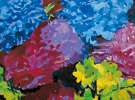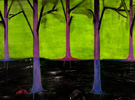Authentic Expression—Keywords of Qu Qianmei’s New Works
Artist Qu Qianmei has grown up in the south of lower reaches of the Yangze River where bursts forth talent. She has studied painting since her childhood and then lived in France for more than twenty years while she has never given up her persistence in art. Since the beginning of this new century, she embarks on abstract painting with teachings of senior masters such as Zhao Wuji, Zhu Dequn and so on. Her creation are based on spontaneous lyricism and oriented to affective abstraction in style. There are countless choices of directions and styles among tremendously free air of cultures and arts in Paris. In terms of artistic creation, on one hand it is a blessing since artists could display their unlimited imagination and creativity; but on the other hand artist might have to face numerous possibilities since there is no rule that makes the radius of artists in the creative process, which leads to increased difficulty in finding themselves. Hence on the basis of absorptions of languages and styles from senior masters, Qu Qianmei’s earlier abstract creations aim to achieve a breakthrough. Admittedly it is difficult to learn from mature styles from masters and strike out in a new line. However, it is extremely arduous to embark on a completely new artistic path unique to oneself. It is in this context that Qu Qianmei starts her own independent creation. How to get rid of the stigma left by masters? How to find self at the tremendously diversified intersection? They have become the starting point and cornerstone for creative artists in recent years.
Tibet
An occasional trip to Tibet has stirred up Qu Qianmei’s new creations. In modern art history in China, “Tibet” is a worthy source of inspiration demanding our special attention. As early as the 1930s and 1940s, artists such as Wu Zuoren, Dong Xiwen and Pan Shixun have been pioneers who took sketches from Tibet with their vivid display of Tibet’s natural scenery, cultural landscapes at that time; After the 1980s, the new generation of artists represented by Chen Danqing and Wu Changjiang manifested the tough, rugged spiritual content of Tibet and Tibetans. Similarly, facing the unique plateau climate of Tibet and religious feelings of devout Tibetans, Qu Qianmei gets inspiration from deep soul which evokes her surging creativity, just as she said, “I could not help venting, and I have already found my direction.” Whereas her new series of works are still quite different from masterpieces depicted Tibet in First Step on Golden Road and Paintings of Tibet in Series. This kind of difference does not lie in visual symbols and styles but in the essence. For Qu Qianmei it is not important at all whether she depicts Tibet or not while the key rests with that it shocked the artist’s soul and opened a door to be light and spacious for her paintings. Also in this sense, we could acquire a better understanding of epochal connotation Tibet has bestowed art and artists from Qu Qianmei’s paintings and the contemporary standpoint; it is not only some exotic scenery that could be recorded, but also a spiritual homeland which could heal anxieties of modern people.
Abstraction
Abstract art is one of the most representative art styles in entire modern art history and also the main manner that Qu Qianmei has adopted for nearly ten years. Even if from the whole situation of contemporary art, it is also a hot spot among mostly discussed issues. It is only two years since Qu Qianmei returned China to create, so her exploration does not contain strong local relevance which possessed by many domestic abstract artists. But in this sense, her paintings happen to rule out the utility of “promotion of the development in Chinese contemporary art”, and they are more purely aesthetic and connote personal emotions. If critical realism, Dadaism and other art schools have represented the involvement of art in society, by contrast abstract art constitutes the spiritual world, ideals and world views that are expressions of human beings with its pure, non-realistic visual form. Similarly, Qu Qianmei’ abstract art has also gone through quite a long period that she utilizes color contrast, fusion, form structure, lines as her primary means of creation to express her individual emotional world; but the artist’s new works make a switch as she adopts thoroughgoing subtraction to form a majestic atmosphere in reddish brown and black ash with the most concise form. On the one hand, as mentioned before it comes from the direct inspiration to her from Tibet; on the other hand, it implies the developing logics of abstract art.
Materials
If previous paintings of Qu Qianmei belong to typical plane canvas creation, then her new creations of this year have effectively broken her usual way of painting and instead focus more on materials by applying integrated art skills in her creation and artistic expression. The formation of this new language by the one hand thanks to the inspiration from Tapies; on the other hand it stems from her study at the Central Academy of Fine Arts. She has repeatedly talked with me about her feelings when she visited Tapies’ exhibitions in Europe which make her so exciting that she paid her visits again and again, thus lord of that gallery was deeply impressed by her since such faithful audience is indeed unusual. Within abstract artists, Tapies is different from Kandinsky, Mondrian, Hans Hartung, etc. Rarely does he adopt grease paint to create, he uses different materials and relationship among them to generate images which superimpose on each other. Qu Qianmei has absorbed such means and taken advantage of it. Meanwhile, in 2008 she pursued her further training at Zhang Yuan studio, Central Academy of Fine Arts. Zhang’ studio is featured as material art creation which paves a new way for Qu’s creations. Mixed media on canvas could already be found on Picasso’s late works where sand, newspaper and wood board could be used here and there. Undoubtedly they expand the expression of paintings. Qu’s paintings usually contain common materials of sand and rope with rough sand piled into hills and gullies coupled with profound colors, which appears deep, natural and spectacular. The use of rope adds a touch of rough forthright spirit to her paintings.
Qu Qianmei’s new works are all framed with heavy thick steel like a strong force could pry the door leads to hearts of audience. It could be said that her works express realistically the living state and survival ideals of modern people. From studies on masters to cultivation of individual way, from freehand abstraction to dignified new works after her trip to Tibet, Qu Qianmei has taken an important step on her own artistic path. Facing the process of creating these new works, one could also get a glimpse of subtle changes if he or she carefully observes: in Qu’ earlier stage, she is cautious, thoughtful; along with the development of creation, she stretches more increasingly from both physical and mental aspects which could also be verified from her paintings that she has made smoothly progress in stretch and contraction. Artistic works are always closely related to artists’ lives and feelings. If life is a long river, its creations will appear differently according to changes of currents. Everything continues and we are looking forward to Qu Qianmei’s advancement in her future creation.
Sheng Wei










